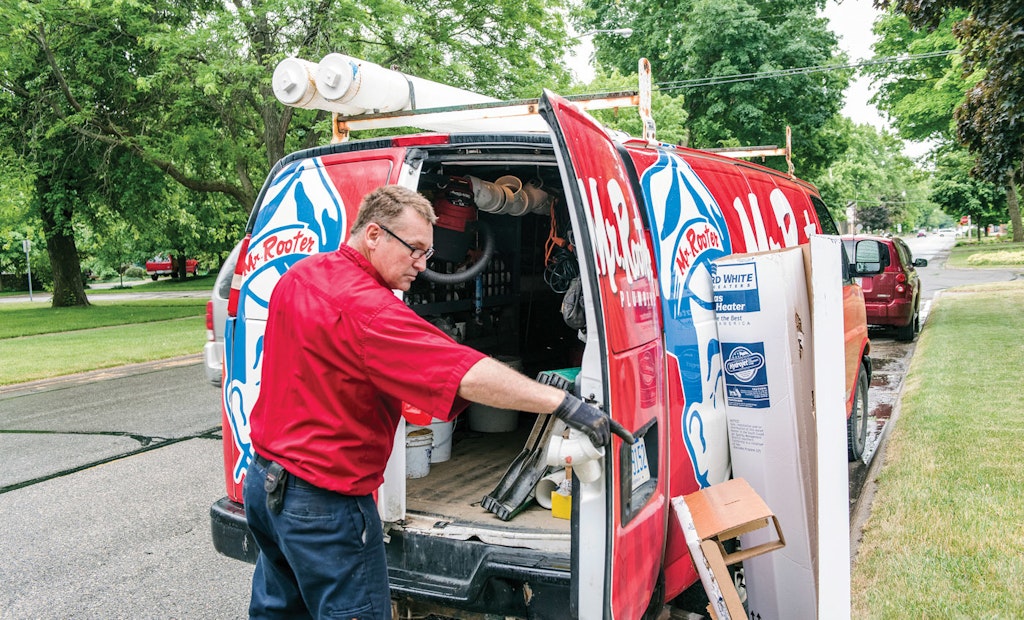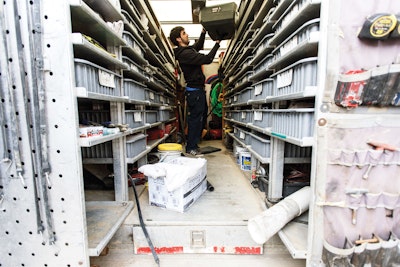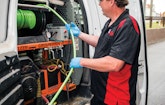
Roger Moore, a Mr. Rooter Mid-Michigan technician, gets supplies from the company van while working at a residence in Mount Pleasant, Michigan. (Photo by Mike Ridewood)
Interested in Trucks?
Get Trucks articles, news and videos right in your inbox! Sign up now.
Trucks + Get AlertsIt might seem like a dramatic claim, but disorganized service trucks can have a real cost for business owners.
“Plumbers are hoarders,” says Brad Sims, owner of Mr. Rooter Mid-Michigan. “It sounds bad, but I reduce my inventory costs by making sure they’re not hoarding.”
Brham Trim, owner of Action Auger, commonly known as The Gentlemen Plumbers, is currently updating his inventory and fleet management practices. He estimates that as much as $10,000 has been lost on some of his trucks due to lax organizational policies.
“We had a truck we were putting a new box on, so we emptied everything out. The first thing that was really frustrating was the amount of certain parts that guys had on their trucks that they probably wouldn’t use for a year,” Trim says. “It was amazing the amount of money that came off those trucks and then just kind of sat there.”
Often, without a disciplined inventory program and methodical storage, crew members end up doubling up on equipment purchases, simply because they can’t find or forget they have a certain fixture or part.
“We talk to guys and they have no idea what they have in their vehicles. Every time they need something, they’re driving to the supply house to get it,” says Rich Gebbia, co-owner of American Van Equipment, which manufactures van accessories and equipment. “In most cases, they have it in their vehicle, but they just can’t find it.”
Finding a solution
Action Auger has a fleet of around 30 trucks, which means even if overstock on a single item isn’t that expensive, the accumulation of parts can add up quickly.
Trim says one of his trucks that was stripped had three bags of a part that isn’t commonly used — bags of 25 each.
“So we had 75 elbows, and in reality, this next year they’ll probably use 10. So you’re carrying this weight, which I guess is minimal for that alone, but overall parts, it’s huge,” he says. “Then there’s the other side of it: These parts are moving around, getting scratched, and they don’t look new anymore, and some of them you just can’t sell.
“We probably carry about $10,000 worth of parts on our trucks, and what we pulled off of that truck was probably double, possibly three times more than what we needed,” Trim says. “It’s capital that’s just being used up, and when you times that by 30 trucks, you’ve got a quarter of a million dollars just sitting there on trucks.”
Unfortunately, there’s no silver bullet when it comes to staying organized. There’s a lot for plumbers to consider: service area, service focus, and fleet size can all play a roll, among other factors.
That’s why Action Augers is developing their own mobile app for tracking inventory across their fleet, where they will be able to coordinate between operators and share parts, effectively turning their fleet into a mobile supply house.
Another example of a customized approach is Mr. Rooter Mid-Michigan.
“We do a lot of stuff different than most companies,” Sims says. “Each company is different in what they specialize in.”
For starters, each of their service vehicles has a specially designed Spartan Tool jetter built into the side door. Inspection monitors have a spot in the cab so they don’t get jostled around, and straps hold their reels upright in the back.
“The majority of it is laid out the same for each truck, but I let the operators put things where they want in their trucks,” Sims says.
They also have pipe racks on the interior of the roof, 200-gallon water tanks for the jetters, and custom bins for all their fittings and other materials.
“Our average job is between 45 minutes and an hour away,” Sims says. “We’re taking a lot of real estate upon our vans, so when it comes to decisions on where, we really have to make sure we’re packing stuff in good locations.”
Pick the right truck
One of the biggest factors to consider is the type of vehicle that fits the operation. The latest trend is away from box trucks and into high-roof vans.
“Seventy percent of the vehicles that come in here, if not more, are higher-roof vans now,” Gebbia says. “A contractor could actually stand up in his van, and store more in his van. The interior capacity is higher.”
Mr. Rooter Mid-Michigan uses Ford Transit vans and 3/4-ton cargo vans. Action Augers is looking to transition into Transit-type vans and are testing out a few different configurations as part of their organizational restructuring.
“With that though, they are smaller trucks, and we’re trying to get more efficient with the actual shelving units that we’re using,” Trim says.
Alongside the increased popularity of service vans is a burgeoning variety of supplementary products.
“Even within shelving there’s a lot of variations that you have to choose from,” Gebbia says. “Obviously, I think everybody would get all the options if it wasn’t a money issue.”
Then again, some contractors take a different approach. Sims says they’ve been testing out some new wood shelving that they built in-house.
“The guys really seem to like them,” he says. “Time will tell if they hold up as well. … But we’re able to pack a lot of material in our truck and keep it where we can do sewer cleaning too, at the same time.”
Try, try and try again
In the end, it’s all about finding what works best, which sometimes involves trial and error.
“We grew extremely fast and never really got an inventory plan in place. We tried a number of times, but it was just something that never really worked for us,” Trim says. “That’s probably our biggest weakness. That’s one of the things right now that we’re focused on to correct.”
As much as physical structure is important, process is potentially even more so. All the shelving in the world won’t matter if operators aren’t utilizing it. Sims goes through inventory with his operators on a weekly basis and has his guys completely strip down their trucks at least once per quarter.
In addition to their custom mobile app, Action Auger plans to add an inventory control manager to their staff as part of their new program.
“It’s important as a matter of efficiency. Time is everything for these guys,” Gebbia says. “The least amount of time on a job you can spend,” the more money you save.







